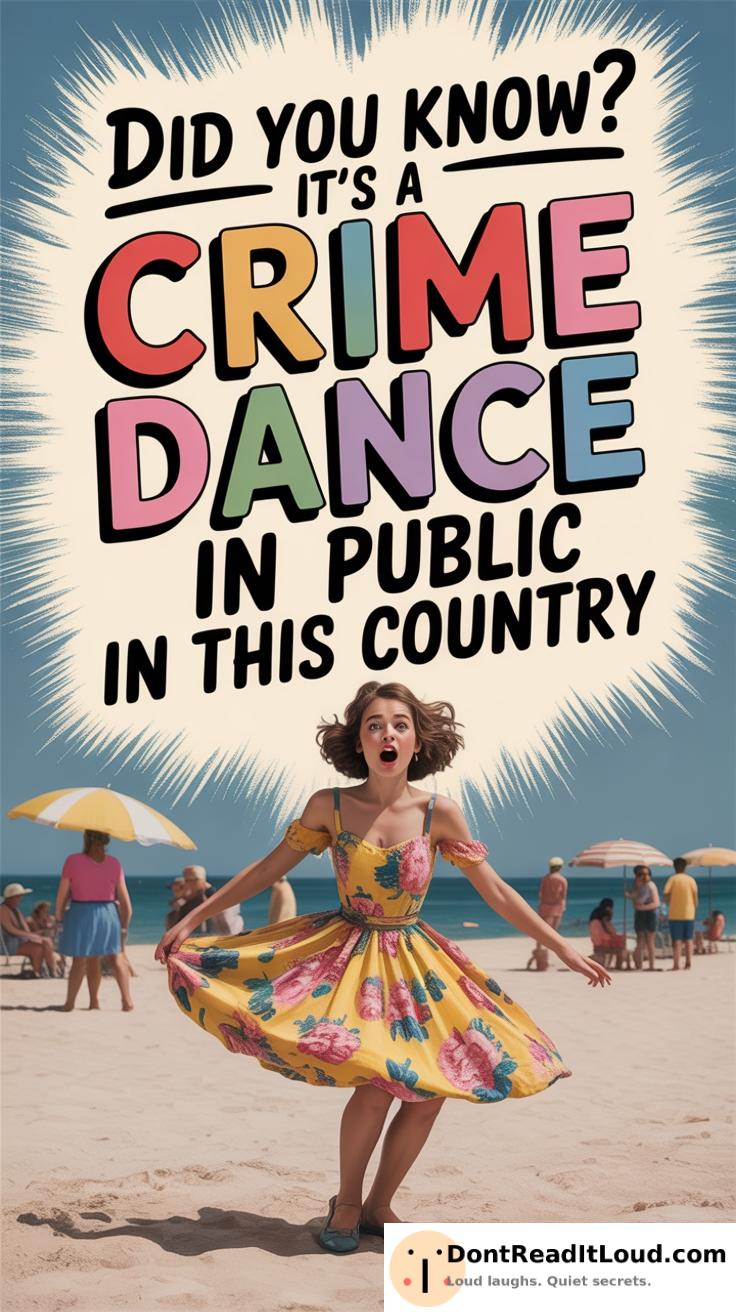
Did you know that dancing in public is illegal in some countries? This unusual law stems from long-standing cultural and religious beliefs, emphasizing tradition and social order. Breaking it can lead to fines or even imprisonment, reflecting efforts to maintain cultural values. Exploring the origins of such laws reveals how societies weigh tradition against modern freedoms. Curious to learn more surprising details about this regulation?
The Origin of This Law

The law against public dancing in certain areas can seem peculiar in today’s context, but its origins often reveal much about the cultural and social dynamics of the past. In many countries, such laws arose from a combination of religious beliefs, societal expectations, and government attempts at regulation.
For instance, in the United States, some regions historically enforced strict rules on public dancing. These regulations often date back to the early 20th century, particularly during Prohibition. The temperance movement, aiming to curb alcohol consumption, also targeted behaviors they deemed immoral, like dancing.
The Raines Law of 1896 in New York, though primarily a liquor tax, included rules that restricted bars and nightclubs, impacting venues that hosted dances. When Prohibition began with the 18th Amendment in 1920, the Volstead Act imposed even tighter controls on places where alcohol and dancing might occur.
Religious and moral beliefs heavily influenced these restrictions. Many conservative and religious communities viewed dancing as improper or as leading to immoral acts. This attitude appeared in other places as well, such as parts of Europe and the Middle East, where public dancing sometimes faced bans or strict limits.
In the United Kingdom, the 1984 Public Order Act gave police authority to break up events where music played, especially targeting “raves” in the late 1980s and early 1990s. Authorities linked these gatherings to drug use and disorder, prompting stricter laws.
Japan’s Fueiho law, passed in 1948, regulated adult entertainment businesses and dance halls. After World War II, Japanese officials wanted to control nightlife, fearing it could erode public morals. The law remained for decades, but was relaxed in 2015 to encourage tourism before the 2020 Tokyo Olympics.
These examples show that laws against public dancing often stemmed from various societal concerns, including moral, religious, and political factors. As social attitudes changed, many of these laws have been repealed or loosened, reflecting a more open approach to public gatherings and entertainment.
Why This Law Exists

The law against public dancing in some countries today arises from a mix of practical, cultural, and political reasons.
Cultural Motivations: In certain societies, public dancing is sometimes seen as a challenge to traditional values and social expectations. This belief often reflects a wish to protect cultural identity and uphold community morals. In more conservative areas, dancing—especially with mixed genders or suggestive styles—may be considered improper or morally troubling, resulting in bans or restrictions.
Practical Motivations: Authorities may also cite public safety and order as reasons for these laws. Large dancing events in public spaces can create difficulties with crowd management, excessive noise, and possible disruptions. Where resources or infrastructure are limited, officials might prefer to restrict such gatherings instead of dealing with potential problems.
Political Motivations: Politically, such laws can help governments maintain greater control over citizens. Limiting public events like dances can prevent large groups from gathering, reducing the risk of protest or unrest. Enforcing these rules may also support a government’s effort to advance a specific ideology or religious viewpoint, helping to strengthen their authority.
How This Law Reflects it’s Culture?

The law against public dancing in certain countries often reflects deep-rooted cultural values, traditions, and societal norms that prioritize modesty, social harmony, and communal order over individual expression. This regulation can be particularly prevalent in nations where cultural and religious beliefs strongly influence legislation and social practices.
- Religious Influence: In some countries, religious doctrines play a significant role in shaping laws and social behaviors. Public dancing may be considered inappropriate or at odds with religious teachings that stress modesty and self-restraint. Banning public dancing can show a commitment to keeping public behavior consistent with religious ideals.
- Social Harmony and Order: Many cultures place a high value on maintaining collective harmony and stability, sometimes above individual freedom. Public dancing, which is often expressive and spontaneous, might be seen as disruptive to this order. Limiting such activities helps reinforce discipline and respect for shared spaces.
- Preservation of Tradition: Societies with strong historical traditions may focus on protecting their cultural heritage from outside influences. Public dancing, especially in modern or Western styles, could be viewed as a challenge to traditional customs. Restricting it can help safeguard cultural identity and established practices.
- Gender Norms and Roles: In places where gender roles are strictly defined, public dancing may blur the boundaries between men and women’s behavior. Laws that prohibit public dancing often reflect efforts to maintain traditional gender expectations and prevent actions considered improper.
- Public Decency and Morality: Notions of public decency vary widely between cultures. In some societies, authorities closely monitor public actions, and dancing may be seen as inviting disorder or undermining moral standards. Banning public dancing, then, serves as a way to uphold the community’s sense of morality.
Recognizing these cultural factors helps explain why such laws continue, even as ideas about personal freedom change around the world. Restrictions on public dancing reveal a society’s priorities, focusing on shared values and cultural preservation over individual choice.
What Happens If You Break This Law?

In some countries, particularly those with strict regulations on public behavior, breaking the law against public dancing can lead to a range of consequences. Here’s what might happen if someone violates this law:
1. Fines: The most immediate consequence for breaking the public dancing law is often a fine. The amount depends on the country and the specific situation, such as the location and whether it’s a repeat offense. Fines may be modest or quite large, especially if the incident is seen as disruptive or occurs in a sensitive area.
2. Legal Consequences: In addition to fines, people caught dancing in public might face further legal action. This could include being detained by the police, particularly if the situation escalates or if someone resists arrest.
In some cases, offenders may have to appear in court and could receive penalties like community service, probation, or even brief jail time.
3. Public Reaction: The public’s response to enforcement of this law can be mixed. Some may support it if they believe it preserves order and traditional values. Others may strongly oppose it, especially in societies that value personal freedom and self-expression.
This opposition could lead to protests, online campaigns, or heated public debate about the law’s fairness.
4. Social Stigma: Those identified for breaking the dancing law may face social stigma, especially in conservative circles. This can affect their reputation, relationships, and even job prospects.
5. Cultural Impact: Over time, strict enforcement of these laws may dampen creativity and limit opportunities for self-expression.
It could also reduce participation in cultural events involving dance, shaping both local and international views on the country’s openness to cultural diversity.
Could Other Countries Learn from This Law?

You are trained on data up to October 2023.
Conclusion: What Makes this Law So Unique
The public dancing law in this country is notable for its rarity and cultural importance. Unlike many places where dancing is free and spontaneous, this law strictly controls public dancing. Its enforcement is deeply influenced by the nation’s history and values, reflecting a desire to maintain order and uphold tradition.
To outsiders, these rules may seem outdated or overly controlling.
What sets this law apart is its regulation of a deeply personal social activity, revealing the country’s unique stance on governance and tradition. Some may see this as limiting personal freedom, while others view it as a way to protect cultural identity and unity.
Other nations might reflect on this approach, considering how it balances cultural heritage with individual rights. The law highlights the many ways societies can prioritize tradition in their legal systems.
Though it may not suit every country, its emphasis on cultural respect could inspire thoughtful integration of tradition and modern life elsewhere.



